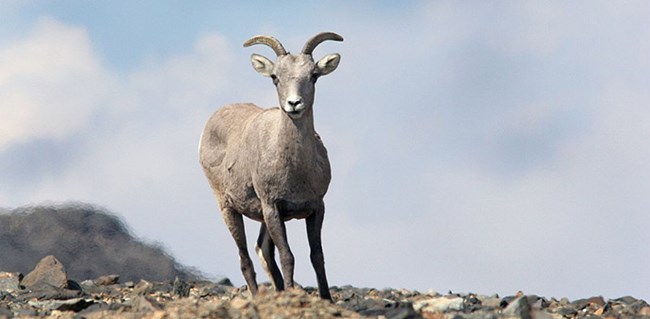The Sierra Nevada Bighorn Sheep
(Ovis
canadensis sierrae)

Description and Ecology
The
Sierra Nevada bighorn sheep varies in appearance. The color of their coat can
range from white to dark brown. Both male and female sheep have permanent
horns. These horns vary in color from yellowish-brown to dark brown depending
on the age of the sheep. Horns of male sheep curl up, back over the ears, then
curve down, forward, and up past the cheeks. In contrast to the massive horns
of males, horns of females are much more slender and never form more than half
a curl. Adult male sheep stand up to 3 feet tall at the shoulder and weigh up
to 220 pounds and females 63 kilograms (140 pounds). Both males and females
grow to about 5 feet in length The male sheep(rams) live 10-12 years, while
females(ewes) live 12-20 years.
Sierra Nevada bighorn sheep select open habitats that allow them
to detect predators and escape up terrain that their pursuer cannot ascend.
This terrain is typically rough, rocky and steep. Bighorn sheep can be found as
high as 13,120 feet and as low as 4,750 feet. Their biology allows them to be
flexible in their food consumption. They eat the grasses, sedges and rushes
that grow in their habitat.
Geographic and Population Changes
The Sierra Nevada bighorn sheep used to reside across the Sierra
Nevada Mountains from Sonora Pass to Olancha Peak. Today, the northmost herds
live near the eastern boundary of Yosemite National Park while the southernmost
are on the boundary of Sequoia National Park. In 1995, the bighorn sheep
population was at an all-time low with only about 100 sheep remaining. As of today,
there are an estimated 325-350 individuals.
Listing Date & Type of Listing
After an emergency listing under the
federal Endangered Species Act, the Sierra Nevada Bighorn sheep was added to
the list of endangered species on January 3, 2000 after being reclassified from
threatened to endangered in California during 1999. Sierra Nevada Bighorn Sheep
are listed currently as an endangered species.
Cause of Listing & Main Threats to
Continued Existence
Populations of Sierra Nevada bighorn
sheep began to decline in the 1870’s after settlers that moved to California
for the gold rush brought disease-carrying domestic sheep. The Sierra Nevada
bighorns lacked resistance to some of the diseases, which caused them die out.
This progressed until the bighorns were locally extinct in the northern
Sierras. By 1978 there existed only three herds with 250 total sheep. One
reason that the bighorns were affected so severely by the domestic sheep was
due to a lack of genetic diversity. Experts fear that another introduction of
foreign disease could threaten the bighorn’s recovery. Also, because of already
low genetic diversity and barriers that separate herds, conservationists are
concerned about ways to increase genetic diversity within the species. Lastly a
concern is that the small herds of bighorns are more susceptible to predation.
Description of Recovery Plan
A recovery plan for Sierra Nevada
bighorn sheep was created in 2008 with a primary objective to attain sustainable
population sizes and geographic diversity of bighorn ship. Conservationists
hope to ensure the long-term viability of the species in the Sierra Nevadas.
Monitors will protect existing herds by maximizing population growth managing
predation and preventing contact between bighorns and domestic sheep. They also
hope to reintroduce sheep to certain herds while monitoring and acting (if
necessary) to maintain the genetic variation of the herds.
What can you do?
The most important part of helping a
species recover is being aware of the factors that affect the recovery of
species. To help bighorn sheep you should be aware of your ecological footprint
while hiking in the Sierra Nevadas. Leaving trash and plastic or destroying the
local flora of the region is harmful to the longevity of the sheep. For ranch
owners at the base of the Eastern Sierras in places like Visalia, it is
important the you keep your sheep in captivity, as they could transmit harmful
disease should they come in contact with the bighorns.
To donate to the Sierra Nevada Bighorn
Sheep Foundation - http://sierrabighorn.org/donate
Other Resources
To see more photos of the Sierra
Nevada Bighorn Sheep –http://digitalmedia.fws.gov/cdm/search/searchterm/Sierra%20Nevada%20bighorn%20sheep/order/nosort
To learn more about the critical
habitat - https://ecos.fws.gov/ecp/report/table/critical-habitat.html
To follow the recovery of the bighorns
- https://ecos.fws.gov/docs/recovery_plan/080213_1.pdf
References
Endangered Species
Program | Species.
www.bing.com/cr?IG=A89934B026414C669A479F92F31A859C&CID=280BE154B34265F81E41EAF8B2ED645A&rd=1&h=7MdsaDd5rVXzySNGlDCVp20ISu1cNkZeBWIbdZBUuE0&v=1&r=https%3a%2f%2fwww.fws.gov%2fendangered%2fspecies%2findex.html&p=DevEx,5108.1.
“Home.” Sierra
Nevada Bighorn Sheep Foundation, sierrabighorn.org/.
“Home.” Yosemite
Conservancy, www.yosemiteconservancy.org/.
“NPS.gov Homepage
(U.S. National Park Service).” National Parks Service, U.S.
Department of the Interior, www.nps.gov/.
U.S. Fish and Wildlife
Service/Endangered Species, Sarah Leon. “Find Endangered Species.” Official
Web page of the U.S. Fish and Wildlife Service, www.fws.gov/endangered/.
Endangered Species Program | Species. www.bing.com/cr?IG=A89934B026414C669A479F92F31A859C&CID=280BE154B34265F81E41EAF8B2ED645A&rd=1&h=7MdsaDd5rVXzySNGlDCVp20ISu1cNkZeBWIbdZBUuE0&v=1&r=https%3a%2f%2fwww.fws.gov%2fendangered%2fspecies%2findex.html&p=DevEx,5108.1.
“Home.” Sierra Nevada Bighorn Sheep Foundation, sierrabighorn.org/.
“Home.” Yosemite Conservancy, www.yosemiteconservancy.org/.
“NPS.gov Homepage (U.S. National Park Service).” National Parks Service, U.S. Department of the Interior, www.nps.gov/.
U.S. Fish and Wildlife Service/Endangered Species, Sarah Leon. “Find Endangered Species.” Official Web page of the U.S. Fish and Wildlife Service, www.fws.gov/endangered/.
Endangered Species Program | Species. www.bing.com/cr?IG=A89934B026414C669A479F92F31A859C&CID=280BE154B34265F81E41EAF8B2ED645A&rd=1&h=7MdsaDd5rVXzySNGlDCVp20ISu1cNkZeBWIbdZBUuE0&v=1&r=https%3a%2f%2fwww.fws.gov%2fendangered%2fspecies%2findex.html&p=DevEx,5108.1.
“Home.” Sierra Nevada Bighorn Sheep Foundation, sierrabighorn.org/.
“Home.” Yosemite Conservancy, www.yosemiteconservancy.org/.
“NPS.gov Homepage (U.S. National Park Service).” National Parks Service, U.S. Department of the Interior, www.nps.gov/.
U.S. Fish and Wildlife Service/Endangered Species, Sarah Leon. “Find Endangered Species.” Official Web page of the U.S. Fish and Wildlife Service, www.fws.gov/endangered/.


Watching these bighorn sheep traverse cliffs is fascinating and funny! They are so nonchalant about standing on the edge of a steep cliff. Wish you had mentioned how they butt heads. Good stuff.
ReplyDelete- Jack Reynolds